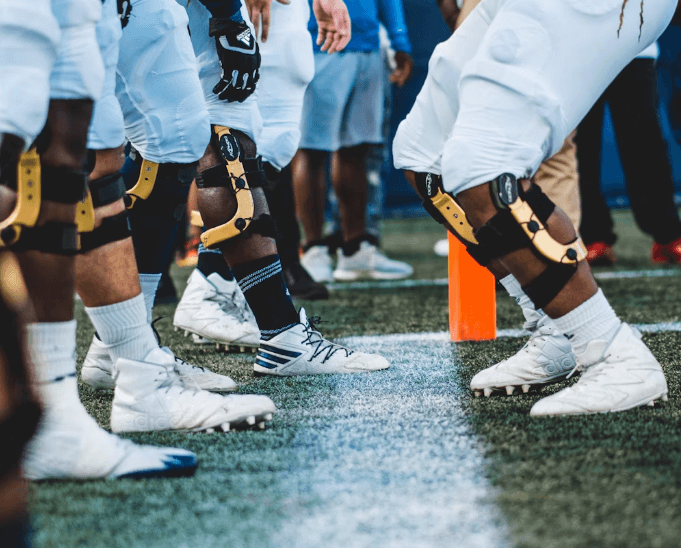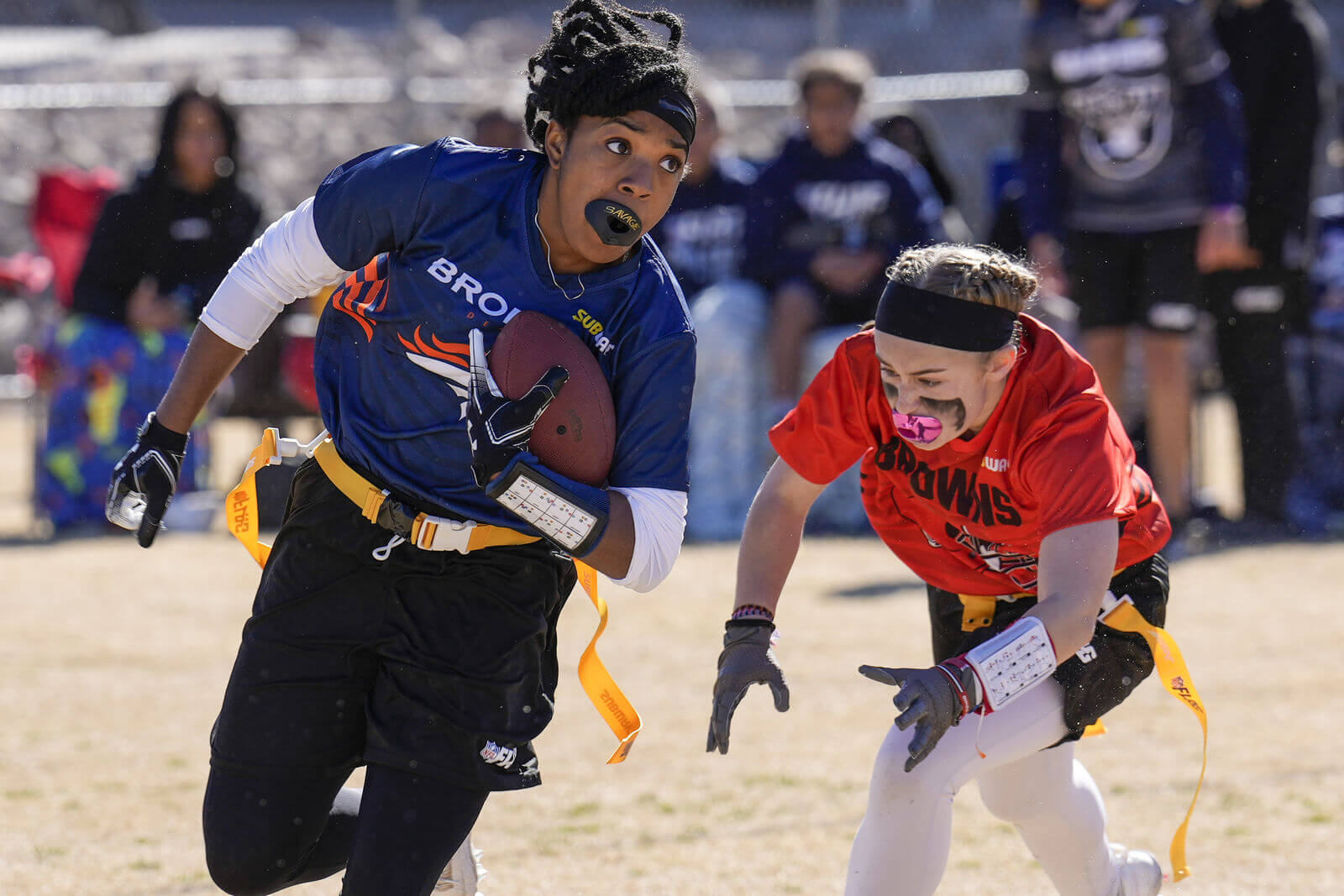AAU Football is a youth sports organization that provides opportunities for athletes ages 6-19 to compete in tackle football. Founded in 1925, it is one of the largest non-school youth football programs in the country.
AAU Football operates under the umbrella of the Amateur Athletic Union (AAU), which was established in 1888 to standardize amateur sports in the United States. The AAU serves over 700,000 youth athletes across 37 sports.
The AAU Football program is divided into age-based divisions, with weight restrictions to ensure safety and fair competition. Teams compete at regional tournaments and national championships. There are also opportunities for high school seniors to be scouted and recruited by college programs.
The mission of AAU Football is to promote the sport of football by providing well-organized programs that teach skills, teamwork, discipline and sportsmanship. The emphasis is on participation, healthy competition, and developing well-rounded student athletes.
Age Groups and Divisions

AAU football is organized into different age groups and divisions for players. The age groups range from 6U up to 19U, with each group representing the maximum age for that division.
The age groups are:
- 6U – 6 years old and younger
- 7U – 7 years old and younger
- 8U – 8 years old and younger
- 9U – 9 years old and younger
- 10U – 10 years old and younger
- 11U – 11 years old and younger
- 12U – 12 years old and younger
- 13U – 13 years old and younger
- 14U – 14 years old and younger
- 15U – 15 years old and younger
- 16U – 16 years old and younger
- 17U – 17 years old and younger
- 19U – 19 years old and younger
The type of play varies across the different age groups. For the youngest levels like 6U to 8U, the focus is on teaching fundamentals and basic skills through practices and jamborees. Tackling and full contact is not allowed at these ages.
From 9U and up, teams participate in full games with referees, scores, and standings. Tackling and full contact begins at these upper age levels. The older age groups like 16U and 19U play 11-on-11 tackle football that closely mirrors high school and college-level play.
Benefits of AAU Football
AAU Football provides many benefits for young athletes.
Some of the key benefits include:
-
Developing skills and fundamentals. AAU Football focuses on skill development through coaching and competition. Players can improve core skills like throwing, catching, blocking, tackling, route running, and more.
-
Provides competition experience. AAU leagues and tournaments give players game experience against teams from across the region or country. This experience can be invaluable for improving through live competition.
-
Can improve chances of making school teams. The additional development and experience from AAU can give players an edge when trying out for school teams. Players improve and gain confidence.
-
Opportunity to play more than school season. School football is limited to a season, while AAU provides year-round opportunities for training, camps, leagues, and tournaments. Kids who love football get to play more.
-
Can help earn college recruitment. College coaches recruit at AAU tournaments. The extra exposure and development can improve chances of being noticed and recruited.
AAU vs High School Football

AAU and high school football are two popular options for youth football players, but they have some key differences.
The main differences are:
-
Season length – The AAU season is generally during the spring and summer, while high school football is in the fall. This allows athletes to play both. The AAU season is shorter at around 3 months.
-
Commitment level – AAU is generally seen as more laidback and recreational, while high school football requires a bigger time commitment with daily practices and games.
-
Skill level – High school teams usually have a wider range of skill levels since they draw from the student population. AAU tends to attract more serious and competitive athletes.
-
Coaching – Both have paid coaches, but high school coaches are full-time. AAU coaches are often volunteers or have other jobs.
-
Cost – AAU generally costs more since it’s club based, while high school is funded by schools. Expect fees of $100-$300 for AAU.
-
Travel – AAU involves more travel for tournaments, while high school is local.
-
Recruiting – AAU offers more exposure to college scouts.
The pros of AAU are more flexibility, playing time, exposure and a longer season. The cons are higher costs and time commitments. High school football builds school community and local rivalries.
Most athletes can do both to get the benefits of a school team and club experience. The different seasons allow for year-round development. AAU keeps kids active during the offseason. The combination helps maximize recruitment opportunities.
AAU Football Rules
AAU football follows the National Federation of State High School Associations (NFHS) rules, with some modifications for player safety.
The key differences between standard high school rules and AAU rules are:
-
No kickoffs or punt returns – the ball is placed at the 35 yard line after a score and at the 30 yard line after a missed field goal or safety to reduce high-speed collisions.
-
No three-point stance – lineman must be upright to avoid initial contact with heads down.
-
Overtime format – each team gets one play from the 10 yard line in overtime rather than trading full drives to reduce extra play.
-
Strict concussion protocols – any indication of a concussion results in removal from play.
The AAU emphasizes modifying traditional football rules to enhance player safety, especially related to concussions and dangerous collisions. While following standard gameplay, their rules aim to reduce injury risk.
Costs and Expenses
Participating in AAU football can be an expensive endeavor.
Here are some of the main costs involved:
-
Registration Fees: AAU requires an annual membership fee of $16 for athletes ages 8 and under or $24 for athletes ages 9 and older. There are also team registration fees that vary but often range from $100-$300 per player.
-
Equipment Costs: Players need helmets, shoulder pads, pants, jerseys, cleats, mouthguards and other gear, which can total $300 or more upfront. Ongoing costs include reconditioning helmets and replacing worn items.
-
Travel Expenses: Most teams travel for games, camps, clinics and playoffs, sometimes out of state. Gas, hotels, meals and more add up. Expect at least $1000+ per player for travel.
-
Camps and Clinics: Optional camps and training clinics can cost $100-$500 each. They help athletes develop skills and get exposure to college recruiters.
AAU football is an investment, but also offers opportunities for athletes to compete and get seen by college scouts. Weigh costs vs benefits as you consider joining AAU. Grants, sponsorships and fundraising can help offset expenses.
AAU National Championships

The AAU National Championships is the culminating event of the AAU youth football season, bringing together top teams from across the country to compete for national titles. The tournament features competition across multiple age divisions, from 8U up to 14U. Teams qualify for the championships through their performance in AAU-sanctioned leagues and events during the regular season.
The AAU National Championships are held annually in early December, typically taking place in Florida. The event spans several days and utilizes numerous fields to accommodate a full slate of championship games across divisions. In 2022, the championships were held in Orlando and involved over 250 teams vying for titles. The scale of the tournament makes it one of the premier events on the youth football calendar.
The National Championships date back over 15 years as one of AAU’s marquee events for youth football. The tournament provides top teams with a platform to showcase their talent and compete against elite competition from across the nation. For many participants, the event serves as a valuable exposure opportunity and chance to gain experience playing in a high-stakes environment.
College Recruitment
AAU football can be a great way for high school players to get exposure and get recruited by college programs. The high level of competition in AAU shows coaches that players can compete against elite talent.
There are many success stories of players using AAU to earn college scholarships. For example, 4-star quarterback Michael Penix Jr. was offered a scholarship by the University of Tennessee after his performance at the Best of the Midwest AAU tournament. Many other top recruits have credited AAU with helping them get noticed and recruited.
Here are some tips for using AAU to get on college coaches’ radars:
-
Perform well consistently against top competition rather than having one breakout game. College coaches attend multiple tournaments.
-
Attend high profile, well-scouted events like the AAU National Championships. Over 1,000 college coaches have attended past championships.
-
Send your information like highlight tapes to coaches after tournaments. Follow up and demonstrate interest in their program.
-
Talk to the AAU coaching staff about contacting college coaches on your behalf. Their experience and network can help.
-
Focus on academic eligibility. AAU’s limited time commitment helps student-athletes keep grades up.
Taking advantage of the exposure from high level AAU events and competition can help propel players to the next level.
AAU vs Club Football
AAU and club football are both competitive youth football organizations that attract talented players looking to take their game to the next level. While they share some similarities, there are some key differences between the two.
Some of the main differences between AAU and club football include:
-
Membership and fees – AAU requires individual player membership fees, while club teams usually charge a team fee. AAU membership provides access to other sports, while club is football-specific.
-
Practice and play – AAU teams typically practice 1-2 times per week and play 8 games in a season. Club teams often practice more frequently with longer seasons.
-
Coaching – Club teams sometimes attract more experienced coaches, while AAU coaches are often parent volunteers.
-
Focus – AAU is generally seen as more recreational, while club football is more competitive and development-focused.
Some pros of AAU football include more affordable fees, the ability to play other sports, and a recreational focus. Club football offers more practice time, experienced coaching, and a highly competitive environment. Many players opt to participate in both AAU and club to get the benefits of each. Playing multiple sports and leagues allows young athletes to develop skills, get exposure, and gain experience before specializing later on. With parental permission, involvement in both AAU and club football can complement each other and provide opportunities for well-rounded development.
Getting Involved with AAU
Getting involved with AAU football starts with finding a local AAU football team. The AAU website has resources to help you locate existing teams in your area. If there are no teams nearby, the AAU provides guidance on starting your own AAU football program.
When looking for the right AAU football program, seek out well-organized teams that emphasize player development over winning. Look for experienced, qualified coaches focused on teaching skills and sportsmanship. Avoid programs that pressure players or families to overcommit.
Tips for parents include being supportive, allowing your child to develop at their own pace, and keeping sports in perspective. Encourage multi-sport participation to build athleticism. For players, listen to your coaches, work hard, have fun, and be a good teammate. Maintaining grades, nutrition, sleep, and safety should be top priorities.
Getting involved in AAU can be rewarding for youth athletes. With sound guidance and reasonable expectations, it provides opportunities to learn, grow, and pursue excellence on and off the field.








